
This article is based on a segment from Process Street‘s Highway 2021 virtual event, where Anne Perry, Process Street’s resident process design expert, shares with us how we’ve built processes for hundreds of teams to help make work fun, fast, and faultless.
Process Design Masterclass: What I’ve Learned Building Processes for Hundreds of Teams was the eighth segment in Process Street’s Highway event.
You can check out our playlist of the full Highway event here, and don’t forget to sign up for free with Process Street!
Here’s the Process Design Masterclass with Anne Perry segment in full:
- Anne Perry: Process Street’s resident process design expert
- Four Ws and an H
- Why: Why does this workflow exist?
- What: What needs to be done?
- How: How do I do it?
- Who: Who does what?
- When: When are things supposed to be done?
Anne Perry: Process Street’s resident process design expert

“My name’s Anne Perry and I’m a Workflow Design Consultant here at Process Street, which means that my job is to work with customers like you to help build your workflows with you as a dedicated strategist, or build them for you with our workflow design services.
This session is about what I’ve learned personally after building hundreds of processes for all sorts of teams, and I’m going to share with you the strategic thinking behind building a process.
It’s one thing to understand what the buttons do, where to click to get the functionality you want, etc., but it’s another thing to think strategically about how to approach documenting and building out a workflow.”
Four Ws and an H
Anne: “There are five questions that you can ask yourself to help you strategically think through your workflows, and those are four Ws and an H.
We’ve got:
- Why?
- What?
- How?
- Who?
- When?”
Why: Why does this workflow exist?
Key takeaways:
- Ask yourself, ‘why does this workflow exist? What’s the starting point? What’s the ending point? What’s its life cycle?’
- Don’t be too vague when defining your workflow.
- Avoid being overly specific when building your workflow.
Anne: “This question is really big picture about defining the workflow itself.
So, we do get a lot of questions where, let’s say, somebody works in the Finance department and they’ll say, ‘you know, I’ve got all the different finance duties, but should I make one workflow for everything I do? Should it be a whole bunch of different workflows? How does that really work?’
The best way to think about it is to figure out, ‘why does this workflow exist? What’s the point of this workflow? What’s the objective of this workflow? What’s the specific purpose?’ So, when you ask yourself, ‘why does this workflow exist?’, that helps to clarify where one workflow ends and another one begins.
Each workflow has one specific purpose, and workflow represents a process with its own life cycle. So, it has one starting point and one ending point.”
Example of the ‘Why?’
Anne: “A sales process.
Why does this process exist? It’s to qualify a lead from the first contact to the decision that they make to work with you, or you make to work with them. So, either the deal is closed or it’s lost.
So, there’s a beginning and an end. It’s got a life cycle. That’s why it exists.”
Potential pitfalls of the ‘Why?’
Anne: “#1 is being too vague.
So, I mentioned Finance as an example. If you build a workflow just called “Finance”, chances are there really should be multiple workflows in there.
There’s payroll, that’s a workflow. There’s quarterly reporting, that’s a whole different workflow. There’s tax prep, that happens once a year, different workflow; these are different workflows, all within the Finance department. They each have their own ‘Why?’
The opposite pitfall can be true as well, which is breaking it down too small.
For example, a video production.
In most cases, you wouldn’t need to separate workflows into a whole bunch of workflows to where there’s one workflow for writing the script, another workflow for editing the video, and a whole other workflow for publishing the video.
It’s really easy, especially in Process Street, to organize your workflow to accommodate lots of people in your team collaborating on different pieces, and to accommodate different timelines and functions.
So, you don’t want to be too vague, and you don’t want to just break it up into too tiny of nitty-gritty little workflows.”
What: What needs to be done?
Key takeaways:
- The ‘what’ gets answered by the tasks.
- A task should answer the questions ‘did this get done? Yes or no? So, what needs to be done?’
- Avoid being too general in your tasks.
- Avoid adding too much detail to a task.
Anne: “This is basically asking what needs to be done in this process.
For example, with our Employee Onboarding workflow, the ‘what’ gets answered by the tasks. So, here on the left hand side, this is your ‘what’.
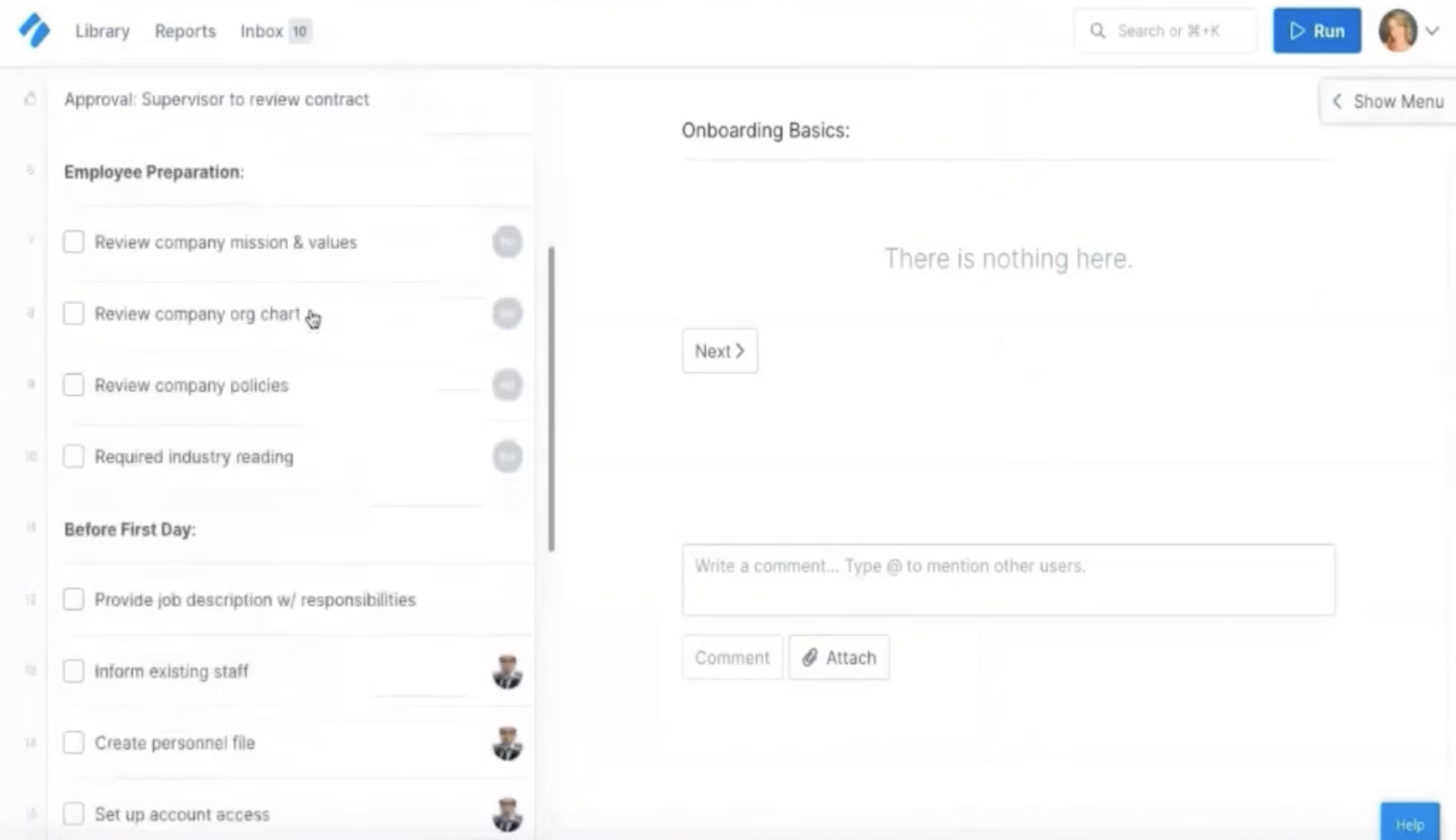
So, when you’re thinking through your workflow, think of it as your to-do list. These are all the steps that are required to complete the process.
A task should answer the question of “did this get done? Yes or no?”, which is why it’s got a handy checkbox. Tasks get checked off as your workflow progresses.
Another aspect of the ‘what’ are headings.
For example, we’ve got a heading called “Onboarding Basics”, another one called “Employee Preparation”. These really organize your tasks into phases or categories.”
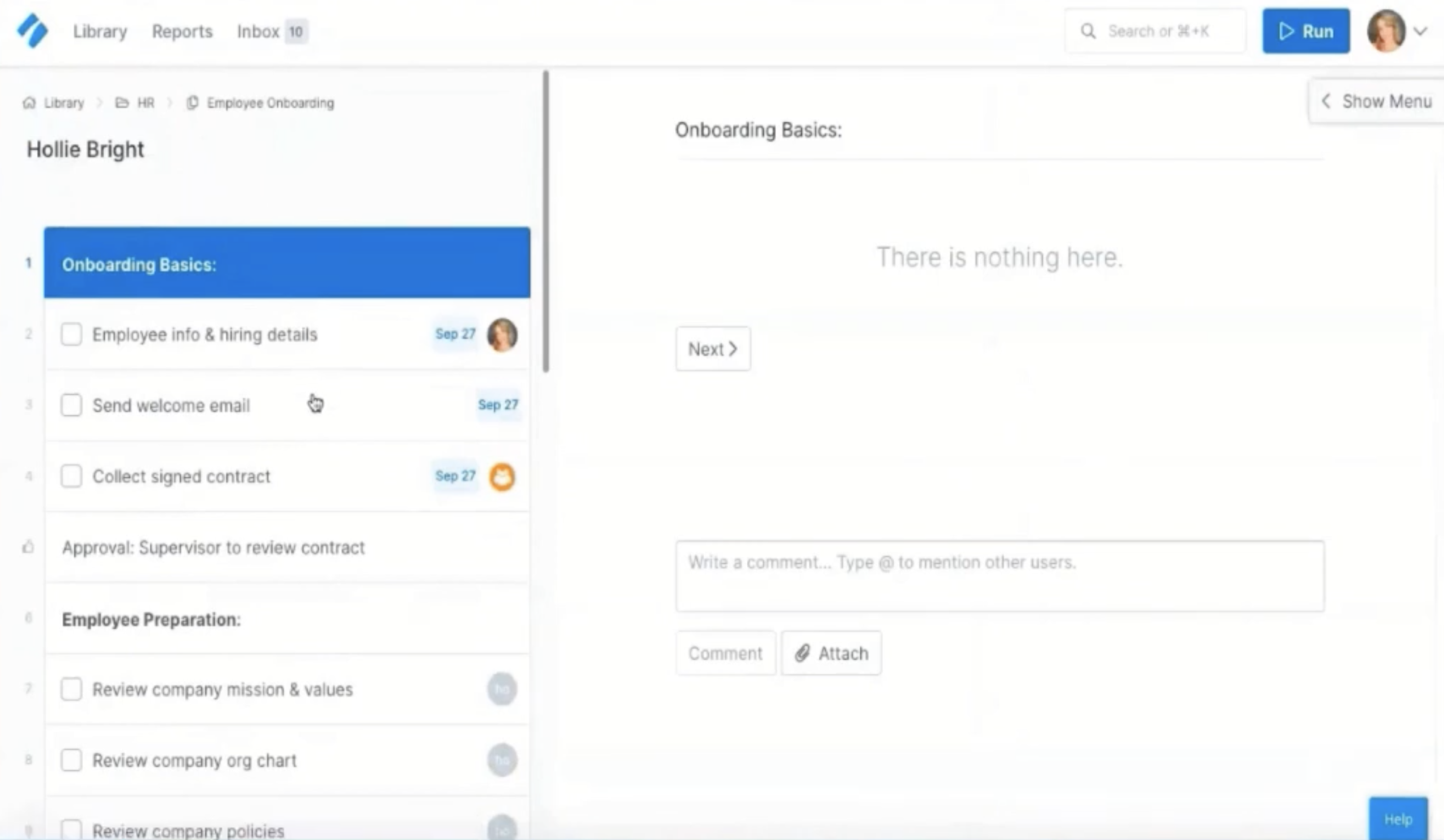
Potential pitfalls of the ‘What?’
Anne: “One pitfall would be being too general in your tasks.
Let’s say the task says, ‘promote the article’, but actually what’s involved in promoting the article is you need to write the promotion copy; you need to have a peer review; you need manager approval, and it gets promoted via six different channels. Well, then that’s actually several different tasks.
So ‘promote the article’, in that case, would be better as a heading, as a main category.
Another pitfall would be adding too much detail to a task.
If you have a task that says something like ‘click to the left side of your screen’ and another task that says ‘click save’, that’s way too much detail.”
How: How do I do it?
Key takeaways:
- The ‘how’ is where you answer the question ‘how do I do it?’ with content and form fields.
- Avoid confusing instructions with to-do.
- If you notice a workflow that’s got some functionality buried in the ‘how’, that’s an opportunity to get a lot more effectiveness out of your workflow.
- All of the data you collect within a workflow can be passed to other applications via Zapier or via native automations within Process Street.
Anne: “This is where we answer the question ‘how do I do it?’, where you would give the instructions of how it can be done, or it’s the actual doing of it.
This is with content and form fields.
So, whereas on the left hand side here, we’ve got all the ‘what’, in the middle here, when you click inside a task, you’ve got all of the ‘how’.
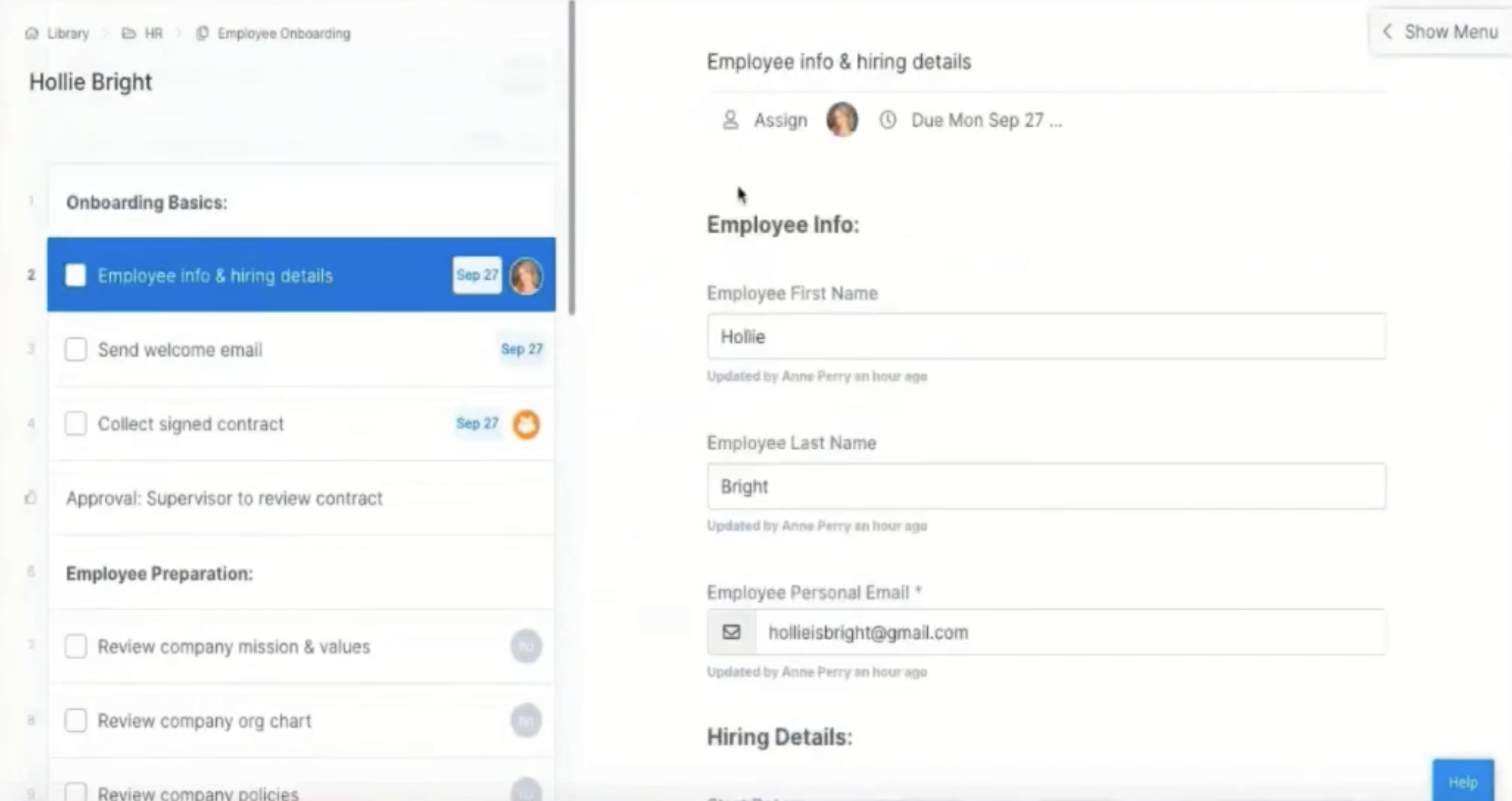
That can look like form fields, where you’re capturing all the information. For example, ’employee information and hiring details’; how do I do that? Well, fill out this information, answer these questions. ‘Send a welcome email’; okay, how do I do that? Well, you’ve got your email widget built out into Process Street ready to go for you and you can just click it and send.
It’s the doing of it.
It also could be instructions or content. For example, this is the section in our Employee Onboarding example where the employee is going to do some tasks. And so we’ve got “Welcome to the team Hollie!”, “watch this video”, “review this company org chart”, etc. It’s the ‘how’.”
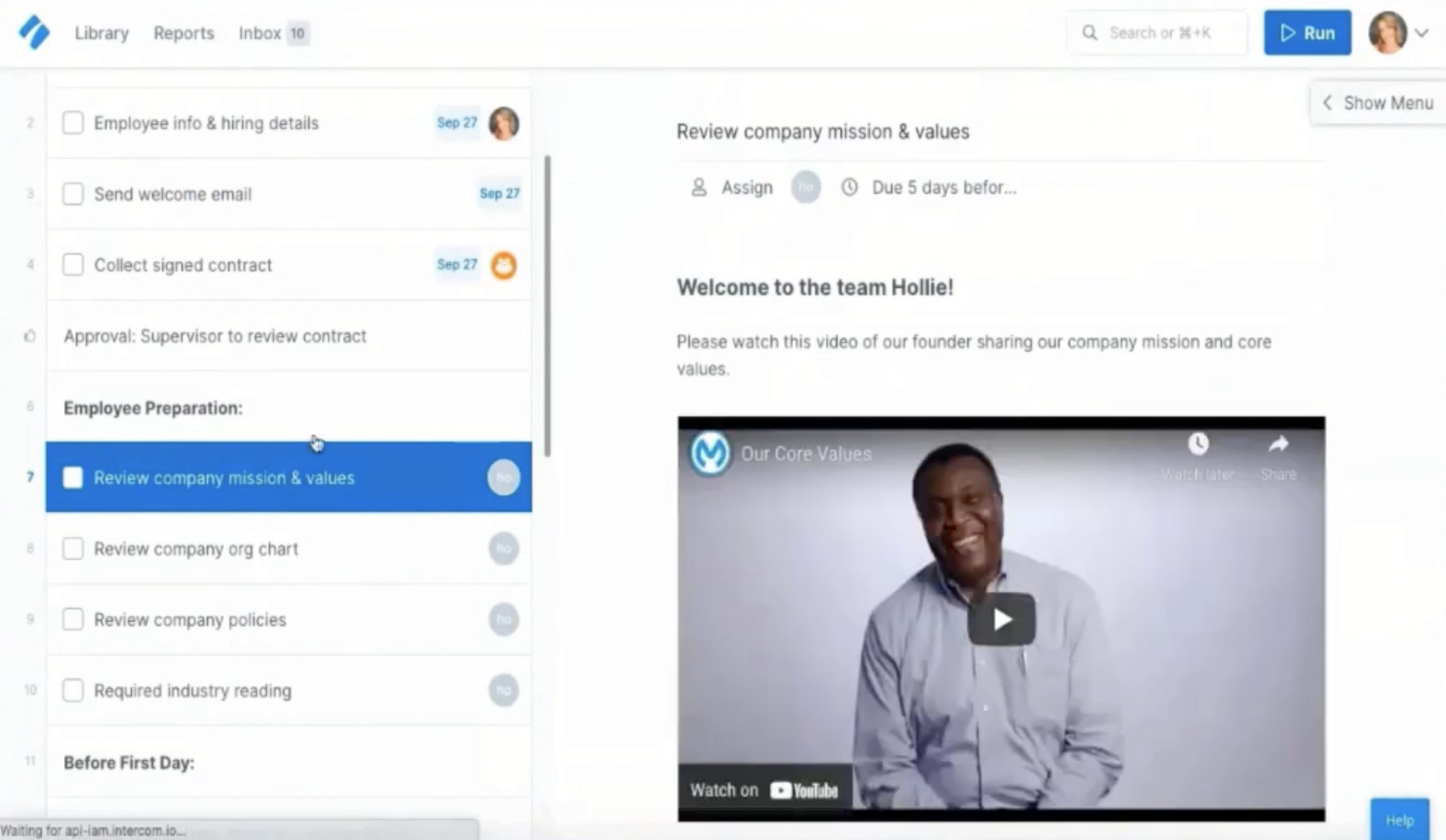
Potential pitfalls of the ‘How?’
Anne: “A pitfall with the ‘how’ is confusing instructions with to-do (in other words, with the tasks).
What I see sometimes that is not wrong, but a missed opportunity as far as getting the most functionality out of Process Street and helping make the team’s lives as easy as possible, is adding way too much detail into the ‘how’.
For example, if you have instructions that say something like ‘be sure the manager approves this before sending the email’ and then ‘follow up on the document at least once a week for three weeks’, there’s actually some functionality buried in those instructions that could make your lives easier.
So, ‘be sure the manager approves before sending the email’ should just be an approval task. Sending the email is a separate task. And then ‘follow up on the document at least once a week for three weeks’, that’s why we’ve got things like due dates and you would make those separate tasks.
If you notice a workflow that you have that’s got some functionality buried in the ‘how’, that’s an opportunity to get a lot more effectiveness out of your workflow.
Also, when using form fields to capture data from within the workflow, keep in mind that all of the data you collect can be passed to other applications via Zapier or via native automations within Process Street. So, you can send this data back and forth to different places, which makes the ‘how’ even easier for you.”
Who: Who does what?
Key takeaways:
- The ‘who’ is where you answer the question ‘who does what?’ with task assignments.
- Task assignments are when you have a specific person who’s always responsible for the same task.
- Rather than an individual, group assignments are assigned to anyone in a specified group of people.
- Role assignments are used when the assignee is not always the same individual, but it’s rather based on their role.
Anne: “So, ‘who does what’ is what you’re asking here. This is where task assignments come in handy.
There’s several ways in Process Street that you can use task assignments.
Task assignment example
Anne: “Task assignments are when you have a specific person who’s always responsible for the same task. For example, we’ve got Tony Stark who is always responsible for these tasks. It’s just always going to be Tony every single time we run a workflow.
Now, a good example of that would be let’s say, Candace the CEO, is always the person who needs to approve expenditures above a certain dollar amount; that’s never going to be assigned to anybody else, it’s always going to be Candace. Then, you can use task assignments and have things automatically assigned to that person every single time.”
Group assignment example
Anne: “Another way to do assignments is with group assignments.
This isn’t used as often as some of the other ways, but group assignments are good when you have an agreement amongst your team, a first-come-first-serve, whoever is on hand at the time.
For example, let’s say you’ve got a front desk staff that is different people working every day that share duties. So, it doesn’t need to be a specific person; it just needs to be done by whoever is working the front desk that day. So, you might just have a front desk group, for example.”
Role assignments example
Anne: “The really powerful one is role assignments. This is good when a task needs to be assigned to a specific person, but that person changes each time.
For example, in our Employee Onboarding workflow, we’ve got certain tasks that need to be accomplished by the supervisor, but there’s a different supervisor for each employee depending on what department they’re in. So, we can just say, ‘okay, well, who’s the supervisor for our new employee Hollie Bright?’, we’re gonna say, ‘Dana, that is the supervisor.’ Now, the moment that I select data from that drop down, Dana gets assigned to certain tasks.
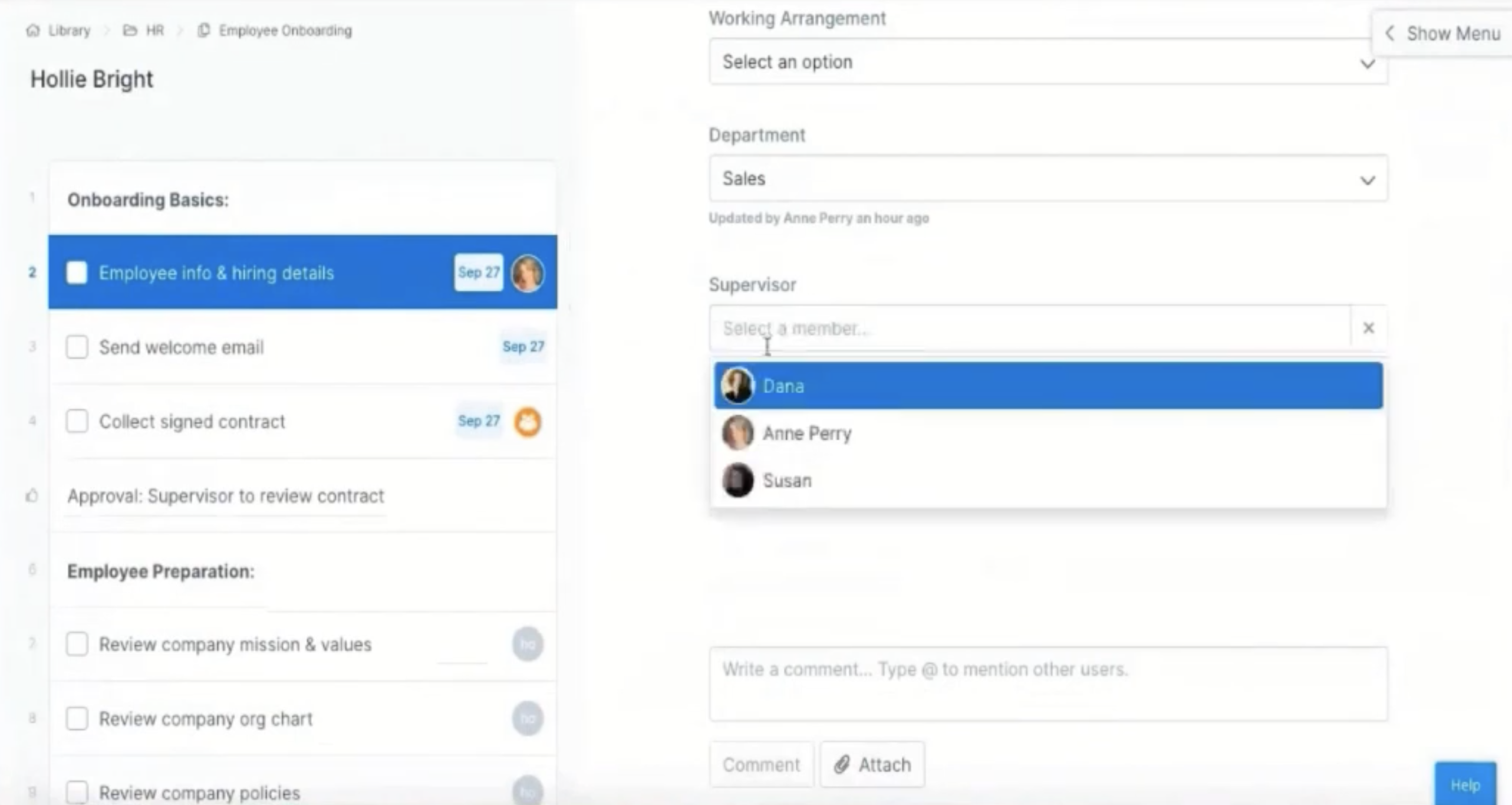
So, that’s role assignments; when it’s not always the same individual, but it’s more so based on their role.”
When: When are things supposed to be done?
Key takeaways:
- The ‘when’ answers the questions ‘when are things supposed to be done?’ and ‘when will it get done?’ with dynamic due dates.
- Dynamic due dates have a dynamic timeline that unrolls itself as you go.
- Dynamic due dates can base dates off of when the workflow run was created, off of date fields, or off of when the workflow run is due.
- Combining both assignments and due dates can improve the effectiveness of your inbox and reports.
Anne: “Let’s talk about the ‘when’. When are things supposed to be done? When will it get done?
The feature in Process Street that really is helpful with this is dynamic due dates.”
Dynamic due dates example
Anne: “What’s super cool about dynamic due dates is that you have a dynamic timeline that unrolls itself as you go, so you can have dates automatically triggered based on when that workflow was run.
You can also have dates triggered off of another date that you capture. For example, when we’re onboarding an employee, there’s lots of things that are dependent on their start date. Let’s say they’re starting on October 15th. The moment we select that their start date is October 15th, the timeline reveals itself. Certain things need to be done a certain number of days before they start; some things happen after they start; it all hinges on that date.
So, you can base dates off of when the workflow run was created, off of date fields, off of when the workflow run is due, lots of ways to do that.”
Level up your Inbox & Reports by combining the ‘who’ and ‘when’
Anne: “What’s really helpful is when you include both assignments and due dates.
When you have the ‘who’ and ‘when’ built into Process Street, your reports and inbox become so much more powerful.
Your inbox becomes a customized to-do list that’s answering the question ‘what should I focus on today?’, handing you the answer on a platter.
In my inbox, I can see that all these tasks are coming up. I can get a head start and see when they’re due, and they’ll always show up in my list for today. It tells me what I should be focused on and when, and that works because we’ve got the ‘who’ and the ‘when’ combined; we have assignments and due dates; and that makes this inbox really powerful.
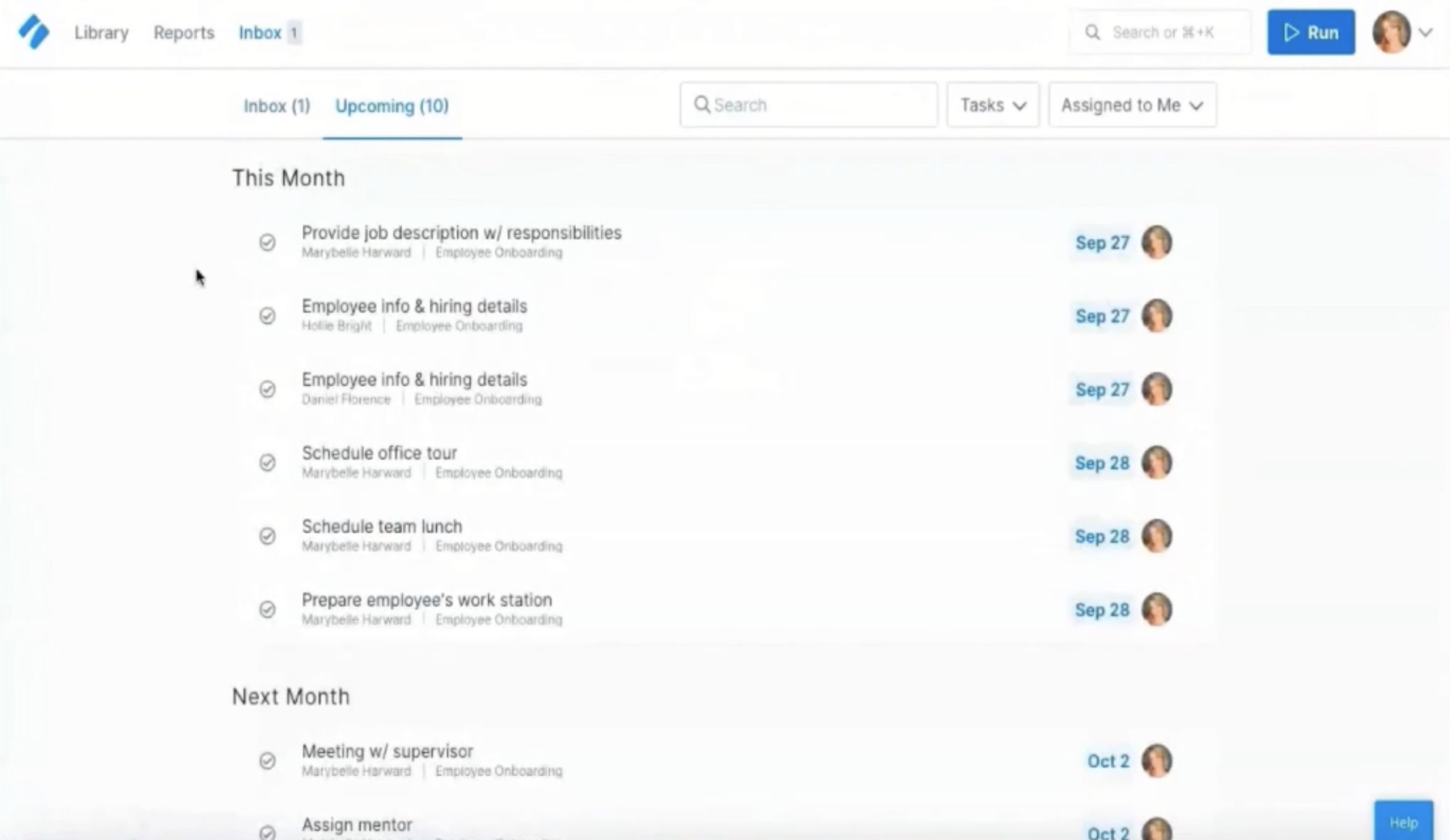
And then same with Reports; you can see what’s going on.
Let’s look at our current onboarding report. We can see who we’re onboarding, where we’re at, we’re overdue on some things, who’s supposed to be doing it, lots of ways to just see the data you need to see, so you can keep a good view on what’s going on in your workflows.”
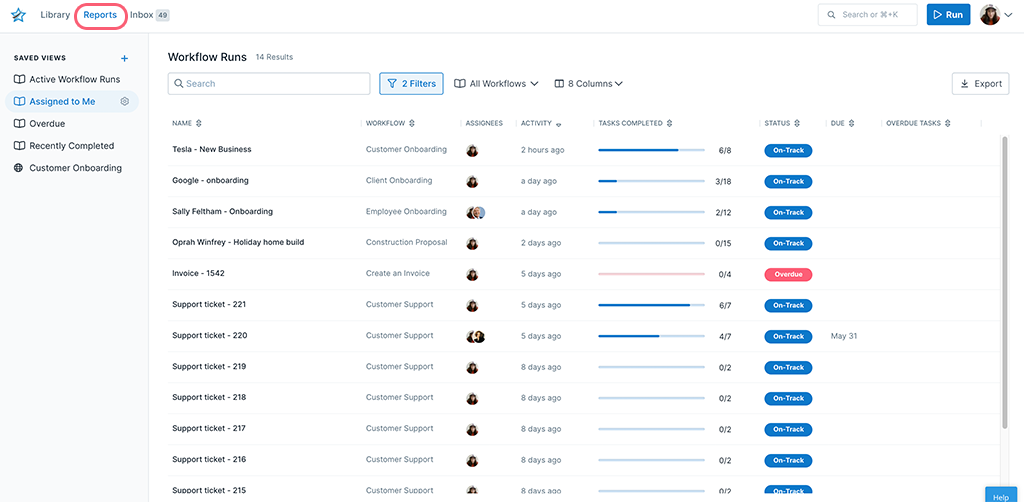
Process Design Masterclass: Final thoughts
Anne: “To recap, we talked about four Ws and an H:
- Why? – Why does this workflow exist?
- What? – What needs to be done?
- How? – How do those tasks get done?
- Who? – Who does each task?
- When? – When is each task supposed to be done?
Whether you build your workflow in Process Street yourself, whether you’re just strategizing with a colleague, or you’re having us build your workflow for you or with you, those questions should really help you think through the best way to build that out.
The biggest takeaway that I can offer here today is to take the time to leverage your time, or delegate to someone on your team, or delegate to us.”
What did you think of Anne Perry’s Process Design Masterclass? Let us know in the comments below!







 Workflows
Workflows Forms
Forms Data Sets
Data Sets Pages
Pages Process AI
Process AI Automations
Automations Analytics
Analytics Apps
Apps Integrations
Integrations
 Property management
Property management
 Human resources
Human resources
 Customer management
Customer management
 Information technology
Information technology



Oliver Peterson
Oliver Peterson is a content writer for Process Street with an interest in systems and processes, attempting to use them as tools for taking apart problems and gaining insight into building robust, lasting solutions.